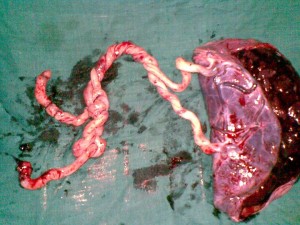Monochorionic monoamniotic twins – Mechanism, Incidence, Complications, Diagnosis and Management
Monochorionic monoamniotic placenta with cord entanglement
Click on image for an enlarged view
Monochorionic monoamniotic twins have single placenta and lie in a single amniotic cavity.
Mechanism:
- It arises from division of the implanted blastocyst 8-13 days after fertilisation
- Division of blastocyst beyond this period results in conjoint twins
Incidence:
- It occurs in 1 in 35000 to 1 in 60000 pregnancies
- It constitutes 1% of monozygotic pregnancies
Complications:
- High risk of cord entanglement – up to 71% (more than 50% of perinatal deaths occur due to this)
- Cord compression – one twin may compress the cord of the other
- Twin – twin transfusion syndrome
Diagnosis:
- Ultrasound scan
- Single placenta
- Absence of inter twin dividing membrane
- Single yolk sac (in most cases)
- Concordant gender
- Cord entanglement later in pregnancy
Management:
- Regular foetal monitoring
- Check for development of complications
- Early termination of pregnancy by caesarean section by 32-34 weeks
- There is increased incidence of cord entanglement after this period
- Steroid administration to promote foetal lung maturity
- Maternal sulindac (selective COX2 inhibitor) has been tried to reduce amniotic fluid volume and thereby risk of cord entanglement
Image credits: Rinoop Ramachandran, Calicut Medical College



